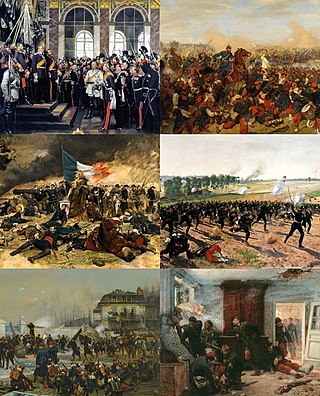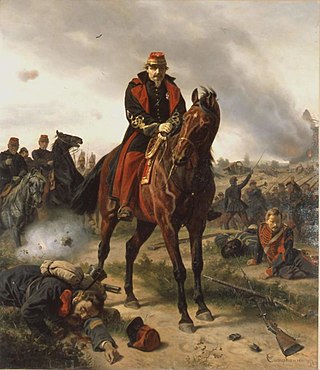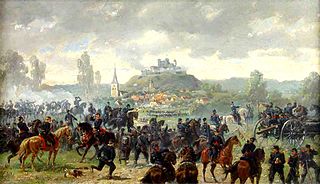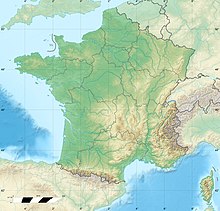
The Franco-Prussian War or Franco-German War, often referred to in France as the War of 1870, was a conflict between the Second French Empire and the North German Confederation led by the Kingdom of Prussia. Lasting from 19 July 1870 to 28 January 1871, the conflict was caused primarily by France's determination to reassert its dominant position in continental Europe, which appeared in question following the decisive Prussian victory over Austria in 1866. According to some historians, Prussian chancellor Otto von Bismarck deliberately provoked the French into declaring war on Prussia in order to induce four independent southern German states—Baden, Württemberg, Bavaria and Hesse-Darmstadt—to join the North German Confederation; other historians contend that Bismarck exploited the circumstances as they unfolded. All agree that Bismarck recognized the potential for new German alliances, given the situation as a whole.

The Battle of Sedan was fought during the Franco-Prussian War from 1 to 2 September 1870. Resulting in the capture of Emperor Napoleon III and over a hundred thousand troops, it effectively decided the war in favour of Prussia and its allies, though fighting continued under a new French government.

Helmuth Karl Bernhard Graf von Moltke was a Prussian field marshal. The chief of staff of the Prussian Army for thirty years, he is regarded as the creator of a new, more modern method of directing armies in the field. He commanded troops in Europe and the Middle East, in the Second Schleswig War, Austro-Prussian War and Franco-Prussian War. He is described as embodying "Prussian military organization and tactical genius". He was fascinated with railways and pioneered their military use. He is often referred to as Moltke the Elder to distinguish him from his nephew Helmuth von Moltke the Younger, who commanded the German Army at the outbreak of the First World War.

The Battle of Gravelotte on 18 August 1870 was the largest battle of the Franco-Prussian War. Named after Gravelotte, a village in Lorraine, it was fought about 6 miles (9.7 km) west of Metz, where on the previous day, having intercepted the French army's retreat to the west at the Battle of Mars-la-Tour, the Prussians were now closing in to complete the destruction of the French forces.

The siege of Metz was a battle fought during the Franco-Prussian War from August 19 to October 27, 1870 and ended in a decisive Allied German victory.

The siege of Paris took place from 19 September 1870 to 28 January 1871 and ended in the capture of the city by forces of the various states of the North German Confederation, led by the Kingdom of Prussia. The siege was the culmination of the Franco-Prussian War, which saw the Second French Empire attempt to reassert its dominance over continental Europe by declaring war on the North German Confederation. The Prussian-dominated North German Confederation had recently emerged victorious in the Austro-Prussian War of 1866, which led to the questioning of France’s status as the dominant power of continental Europe. With a declaration of war by the French parliament on 16 July 1870, Imperial France soon faced a series of defeats at German hands over the following months, leading to the Battle of Sedan, which, on 2 September 1870, saw a decisive defeat of French forces and the capture of the French emperor, Napoleon III.

Alexander Friedrich Adolf Heinrich von Zastrow was a Prussian general who served in the Austro-Prussian War and the Franco-German War.
The Battle of Châtillon, also known as the Battle of Châtillon-sous-Bagneux, was a skirmish in the Siege of Paris between France and North German Confederation in the Franco-Prussian War, took place on 13 October 1870. This is also considered the first battle in the history of the French Third Republic. In this fierce battle – occurred at Châtillon and Sceaux, Corps V of the Prussian army under the command of Lieutenant General Infantry Hugo von Kirchbach, along with the II Corps of the Kingdom of Bavaria by the Supreme Minister infantry Jakob von Hartmann which were the forces of the army Group 3 of Prussia by Prince Friedrich Wilhelm as General command., won a victory against an attack by the XIV Corps under General Renault - of the French army under General Auguste-Alexandre Ducrot. Although some soldiers under Ducrot fought well, the majority of his army became agitated. The French were forced to flee to Paris, losing the Châtillon Plateau - a very favorable defensive position overlooking the fortresses south of Paris - to the Germans. This was a disaster for the "justice" of the French army during the war, although the French reported that they suffered only minor losses.

The siege of Lichtenberg was a battle of the Franco-Prussian War that took place on August 9–10, 1870 at Lichtenberg Castle between French and German troops. After a brief but fierce shelling a German force under the command of Generalmajor Hermann Freiherr von Hügel, part of the Württemberg Division and the Third Army forced the surrender of the French garrison of Lichtenberg under the command of Second Lieutenant Archer. In addition to Lichtenberg, in a single period in August 1870, the German army also defeated the French fortresses of La Petite-Pierre, Marsal and Vitry-le-François.

The siege of Phalsbourg was an early battle of the Franco-Prussian War that was fought between the French Empire against Germany at Phalsbourg near the Vosges beginning on 10 August 1870, and ending on 12 December of the same year.
The siege of Marsal was a battle of the Franco-Prussian War on August 13 to 14 between the French Empire and the combined German forces of Prussia and Bavaria in Marsal Under the command of Lieutenant General Jakob von Hartmann, after replacing the Prussian 4th Cavalry Division, II Corps of the Kingdom of Bavaria forced the surrender of the French Empire's defenses, after a brief resistance by the French troops stationed at the fortress. Marsal fell to the German army in the same period as the French fortresses of Lichtenberg, La Petite-Pierre and Vitry. With the quick victory of the Bavarian army at Marsal, the road from Dieuze to Nancy was open to the Germans. In addition, the siege also brought the Germans a lot of raw materials for the war, as well as hundreds of prisoners.
The Battle of Nouart was fought on 29 August 1870 at the village of Nouart. Part of the Franco-Prussian War of 1870–1871, the battle saw Prince George's 46th Infantry Brigade of the XII Royal Saxony Corps defeat Pierre Louis Charles de Failly's V Corps of the French Empire.

The siege of Montmédy was a battle of the Franco-Prussian War at the small commune of Montmédy, in the Meuse, it was besieged by the army of the German coalition. Defended by the 57th Line Infantry Regiment, the Garde Mobile and elements of other units, it surrendered on December 14, 1870.
The siege of Verdun was a battle fought in France during the Franco-Prussian War from 13 October until 8 November 1870.
The Siege of La Fère took place during the Franco-Prussian War from 15 November until 26 November 1870, at the fortress of La Fère in France. French troops stationed at La Fère under the command of Captain Jacques Ferdinand Planche resisted the siege from the Imperial German Army, but surrendered the fort after eleven days on 26 November 1870, which resulted in a German victory. During the siege, the German army captured thousands of prisoners, most of whom were Garde Mobile soldiers, and took control of many French weapons. The German shelling of La Fère took place over the course of two days and severely damaged the town. After the Germans captured La Fère, they used cannons to arm the stronghold of Amiens.
The siege of Sélestat was a siege, extending from 20 to 24 October 1870, of the French Alsatian fortress of Sélestat, during the Franco-Prussian War. After artillery bombardment by the Germans, the siege ended when the French army surrendered, mainly because the French garrison was demoralized. The Germans suffered only minor losses, while this victory brought them many spoils.
The siege of Mézières was a siege battle during the Franco-Prussian War, it took place from November 17, 1870 until January 2, 1871, in Mézières-en-Gâtinais which is located on the banks right of the river Meuse in France. After suffering from a German artillery strike, the French army at Mézières under the command of Colonel Vernet, surrendered to Germany under the command of Major General Wilhelm von Woyna on January 2, 1871. Although lasting just over a day, German artillery bombardment caused French defenders and civilians in Mézières heavy losses. With the victory, the Germans captured many French officers and soldiers, with many cannons and supplies from the enemy's reserves. Not only that, the victory at the Siege of Mézières made the German army have complete dominance of the railway line in the north extending from Metz and Mézières to Paris, capital of France.

The Battle of Longeau, was a battle of the Franco-Prussian War on December 16, 1870 in Longeau-Percey, near Dijon, France. The fighting lasted about three hours, and ended in a French retreat. Victory went to the Prussian Infantry Brigade under Colmar Freiherr von der Goltz and the German XIV Corps infantry under the command of Lieutenant General August von Werder, over French troops commanded by General Pierre Arbellot de Vacqueur, semt from Langres to Longeau. The French suffered significant losses of both manpower and equipment.
The Fighting in Épuisay was a military conflict of the Franco-Prussian War, it took place on 17 December 1870, in Épuisay where there was a junction of roads from Vendôme and Morée to Saint-Calais. This was a battle between the rear forces of the Armée de la Loire of the French Republic under the command of Antoine Chanzy with the German army in retreat after X Legion being defeated in the Battle of Vendôme on 16 December 1870. Under the command of General Ludwig von der Tann-Rathsamhausen, the German army captured Epuisay and captured 230 prisoners.

The siege of Rocroi was a battle of the Franco-Prussian War, it was held in January 4 to the 6th, 1871 at Rocroi which was a bastion of France located to the west of Sedan. After an artillery fire by the Prussian army, the officer commanding the French troops at Rocroi was forced to surrender the Division Militia under General Schuler and Sendan and Wilhelm von Woyna. With the success of the Siege of Rocroi, the military spectrum was obtained on their hands were hundreds of prisoners along with many stocks, costumes and contemporary heavyweight artillery of the French. During this siege, the town of Rocroi was heavily destroyed. The fall of Rocroi marked one of the German army's consecutive victories in the war.














